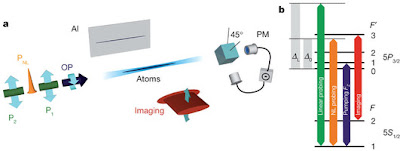Experimental schematic: an ensemble of 700,000 Rubidium atoms, held in an optical dipole trap, is prepared in the state by optical pumping (OP). Probe pulses are used.
Nature – Interaction-based quantum metrology showing scaling beyond the Heisenberg limit
New Scientist – They used a beam of photons to measure the small magnetic field produced by a gas made up of a million ultra-cold rubidium atoms. Normally, the spin of each photon would rotate by a certain amount, thanks to its interactions with the magnetic field of the atoms. But the frequency of the photons was chosen so that the photons also interacted with each other when they were in the gas, so that the presence of one photon altered the way a second behaved. These interactions led to a measurement accuracy that grew in proportion to N3/2 – greater than Heisenberg’s limit
The technique could pave the way for more sensitive searches for gravitational waves – ripples in space triggered by moving objects. The waves should cause the distance between two objects to change, and the study suggests that the laser interferometers used to look for such changes could be made more precise.
Fractional sensitivity of the nonlinear probe plotted versus the number of interacting photons, NNL. Blue circles indicate the measured sensitivity, orange curves show results of numerical modelling
9 pages of supplemental information
If you liked this article, please give it a quick review on ycombinator or StumbleUpon. Thanks

Brian Wang is a Futurist Thought Leader and a popular Science blogger with 1 million readers per month. His blog Nextbigfuture.com is ranked #1 Science News Blog. It covers many disruptive technology and trends including Space, Robotics, Artificial Intelligence, Medicine, Anti-aging Biotechnology, and Nanotechnology.
Known for identifying cutting edge technologies, he is currently a Co-Founder of a startup and fundraiser for high potential early-stage companies. He is the Head of Research for Allocations for deep technology investments and an Angel Investor at Space Angels.
A frequent speaker at corporations, he has been a TEDx speaker, a Singularity University speaker and guest at numerous interviews for radio and podcasts. He is open to public speaking and advising engagements.



